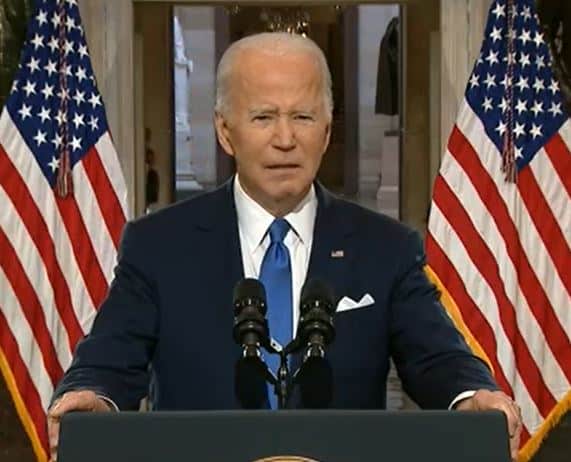Biden Administration Begins Whole-of-Government Efforts to Tackle Long COVID

WASHINGTON — The Biden administration will institute new efforts this week to accelerate prevention, detection and treatment of long COVID.
“There are federal efforts underway at the [U.S. Centers for Disease Control and Prevention] and the [National Institutes of Health] and elsewhere to use artificial intelligence and a variety of other tools to comb the data and literature and try to find the patterns,” said Karen Howard, director of Science and Technology Assessment at the Science, Technology Assessment, and Analytics Office of the U.S. Government Accountability Office, during a phone call with The Well News.
“We don’t know what causes [long COVID]. We don’t know why some people have one set of symptoms, and why other people have different symptoms. We don’t know which people are more susceptible to long COVID, based on demographic, certain age groups, certain comorbidities. There aren’t yet clear patterns, it’s somewhat random in how it strikes currently,” continued Howard.
Long COVID, according to the CDC, is the occurrence of new, returning, or ongoing health problems four or more weeks after an initial infection with SARSCoV-2, the virus that causes COVID-19.
The Biden administration released a presidential memorandum Tuesday which directs the Secretary of Health and Human Services to coordinate a new effort across the federal government to develop and issue the first-ever interagency national research action plan on long COVID.
The plan includes delivering high quality care for individuals experiencing long COVID, by launching centers of excellence and promoting evidence-based care models through the Agency for Healthcare Research and Quality, and increasing the number of long COVID clinics across the country.
In the president’s Fiscal Year 2023 budget, he also requested $20 million to investigate how health care systems can best organize and deliver care for people with long COVID, provide telementoring and expert consultation for primary care practices and advance the development of multispecialty clinics to provide complex care.
The administration will also work to promote provider education and clinical support on long COVID through the Centers for Medicare and Medicaid Services, Medicare Learning Network, and Indian Health Service.
A new project will be launched called Health+, to gain insights into the experiences of patients with long COVID, and efforts will be made to ensure health insurance coverage for long COVID care and raise awareness of long COVID as a disability.
In July 2021, the Biden administration announced that long COVID was included as a disability under the Americans with Disabilities Act.
Research provided by the administration estimates that 1 million people have dropped out of the workforce because of the illness, and between 7 million to 23 million Americans are estimated to have long COVID.
The plan will boost support for workers experiencing long COVID, through the Equal Employment Opportunity Commission and Department of Labor, which recently released guidance on access to equitable employment opportunities for people experiencing the impact of COVID-19 and the symptoms of long COVID.
The Government Accountability Office team of Science Technology and Assessment released a spotlight in March, which is a two-page briefing provided to Congress on all of what is known and currently not known about long COVID.
“We are combing through the data, talking to experts and trying to get a big picture of what has been going on,” said Howard.
“What we don’t have is a lot of conclusions. COVID hasn’t been around very long, and long COVID we didn’t even recognize at the beginning.”
“People can have completely different symptoms. Someone will have severe fatigue and someone else might have severe joint pain. It’s hard to pin it down, and those symptoms are also not specific to COVID,” continued Howard.
So far, Howard said there are a few studies showing that vaccination for some people helps to clear up their long COVID symptoms, as some individuals got vaccinated and found symptoms improved, but the data also shows that doesn’t occur for everyone.
“We [also] know that different variants seem to give rise to different long COVID symptoms,” said Howard.
“The NIH and CDC are big players in long COVID research and trying to comb through the data, and we do know they are encountering some data issues,” said Howard.
“No one knew long COVID was coming, nobody knew there were going to be demographic differences… so much of the early data doesn’t show those flags, those variables, so that the data can be tracked using that information, and that makes it difficult. Data sets are often not compatible with each other,” said Howard.
Alyssa Hundrup, a director from the GAO Health Care team, said during a phone call with The Well News that under the CARES Act, a good share of her work during the pandemic has focused on anything from vaccines to testing, the strategic national stockpile and disparities relating to racial and ethnic COVID cases.
Early evidence from the National Academies of Sciences and Engineering Medicine indicates that COVID-19 is impacting communities of color at much higher rates than the general population, but so far, no studies have confirmed this is true of long COVID.
“That is what really led us to understanding long COVID from a racial and ethnic perspective, given the disparities we are seeing from cases – to deaths,” said Hundrup.
In September of 2020, Hundrup said her team made recommendations to CDC and HHS to share their ability to assess the long-term health outcomes of COVID, and has since then tracked various efforts of those departments to concur with GAO recommendations.
“One of the fundamental challenges… is that [CDC] has said they do not have the authority to require much of this information from state and local health departments,” said Hundrup.
Hundrup said the CDC made headway in this area by requiring labs to report race and ethnicity where they previously were not.
“It comes down to, you have 50 different systems, and then within that, multiple systems… [it’s] a patchwork and there’s not a systematic way that a lot of this [data] is collected,” continued Hundrup.
“Long before COVID, we reported for years that the public health surveillance and data systems in the U.S. were very fragmented, incomplete, and the reporting was very much at mercy of individual labs and hospitals who were collecting the data, and then needing to report it to CDC and others,” said Howard.
“They are just really busy, particularly in the peak of a pandemic, and turning in reports is probably not their highest priority compared to some of the other patient care needs,” continued Howard.
Howard said the GAO has set forth recommendations to Congress to make sure they have the capability to use existing data systems to inform ongoing data collection, and really step back and take an examination of that which might require a whole-of-government approach.
“We will probably at GAO be doing work on long COVID for a decade or more to come, but it doesn’t mean it will take that long to get answers,” said Howard.
Alexa can be reached at [email protected]

























